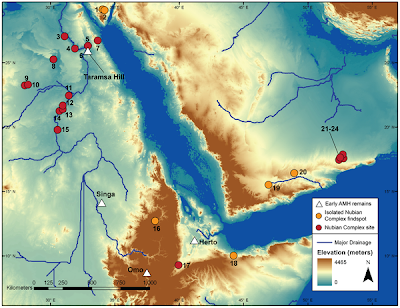Нубийский комплекс в Южной Аравии
Нубийский комплекс в Южной Аравии, 106 тыс. лет назад. Генетики говорят, что выход человека из Африки состоялся гораздо позже. Датировки этого комплекса говорят об обратном, современные люди присутствовали 100 тысяч лет назад на Ближнем Востоке. Возможно, эта общность вымерла, не оставив потомков, более успешными оказались их последователи. Либо генетики делают ошибку, определяя возраст человеческой экспансии до 70 тыс. лет назад, либо Аравия была вторичной прародиной человечества.

"The taxonomic identity of the Nubian Complex toolmakers is unknown, as no skeletal evidence has been discovered in association with any such assemblage. Although some archaic forms may have persisted in other parts of Africa at that time [79], the distribution of early anatomically modern human (AMH) remains suggest this species is the most likely candidate to have occupied northeast Africa during the Late Pleistocene. Cranial fragments of Homo sapiens found in the Omo river valley, Ethiopia (Fig. 1), represent the first appearance of AMH in East Africa ~195 ka [80]. Remains from Herto [81], Singa [82], and Mumba [83] in East Africa date to between ~160 and ~100 ka. Skeletal remains from Jebel Irhoud in Morocco show that an early form of Homo sapiens had expanded into North Africa as early as ~160 ka [84], and a modern human child discovered at Grotte des Contrebandiers in Morocco verifies the presence of AMH in North Africa by ~110 ka [85]. At the site of Taramsa Hill 1 in the lower Nile Valley, an AMH child dated to ~55 ka was found in association with a lithic industry (Taramsan) that is thought to have developed out of the late Nubian Complex [21], [86]. Despite the lack of direct evidence, given that AMH are the only species to have been found in North Africa from the late Middle Pleistocene onward, it is warranted to speculate that the Nubian Complex toolmakers were modern humans".

http://www.plosone.org/article/info%3Adoi%2F10.1371%2Fjournal.pone.0028239

"The taxonomic identity of the Nubian Complex toolmakers is unknown, as no skeletal evidence has been discovered in association with any such assemblage. Although some archaic forms may have persisted in other parts of Africa at that time [79], the distribution of early anatomically modern human (AMH) remains suggest this species is the most likely candidate to have occupied northeast Africa during the Late Pleistocene. Cranial fragments of Homo sapiens found in the Omo river valley, Ethiopia (Fig. 1), represent the first appearance of AMH in East Africa ~195 ka [80]. Remains from Herto [81], Singa [82], and Mumba [83] in East Africa date to between ~160 and ~100 ka. Skeletal remains from Jebel Irhoud in Morocco show that an early form of Homo sapiens had expanded into North Africa as early as ~160 ka [84], and a modern human child discovered at Grotte des Contrebandiers in Morocco verifies the presence of AMH in North Africa by ~110 ka [85]. At the site of Taramsa Hill 1 in the lower Nile Valley, an AMH child dated to ~55 ka was found in association with a lithic industry (Taramsan) that is thought to have developed out of the late Nubian Complex [21], [86]. Despite the lack of direct evidence, given that AMH are the only species to have been found in North Africa from the late Middle Pleistocene onward, it is warranted to speculate that the Nubian Complex toolmakers were modern humans".

http://www.plosone.org/article/info%3Adoi%2F10.1371%2Fjournal.pone.0028239